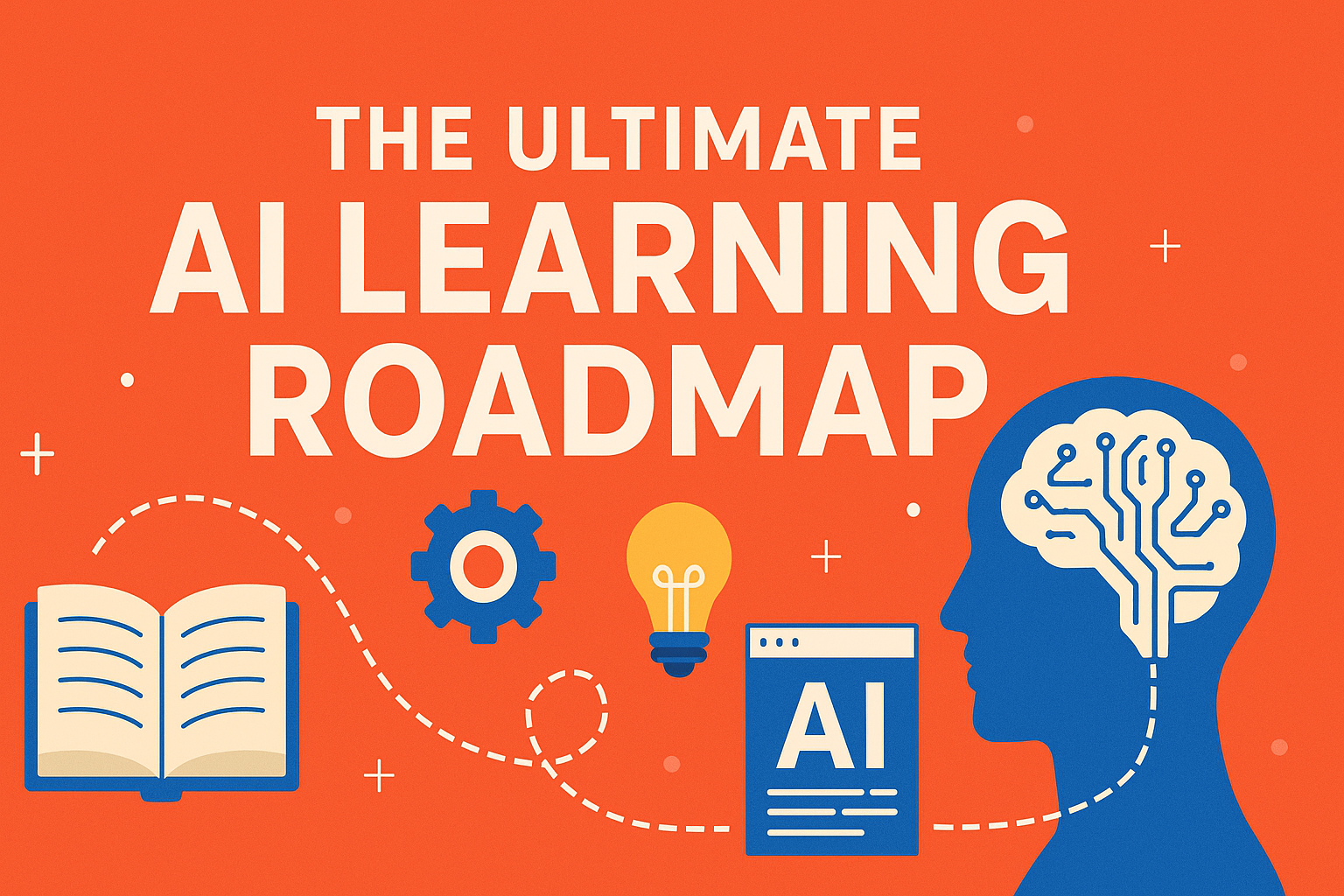Learn Artificial Intelligence from scratch with this step-by-step AI learning roadmap. Includes essential concepts, resources, projects, and infographics to guide your AI journey.
Introduction
Artificial Intelligence (AI) is transforming every industry, from healthcare to finance, and the demand for AI-savvy professionals has never been higher. But for newcomers, navigating the vast AI landscape can feel overwhelming. This comprehensive AI learning roadmap (2025 edition) provides a step-by-step path from beginner to expert, complete with top resources, real-world projects, and visual infographics to make your learning engaging and actionable.

Stage 1: Fundamentals of AI & Python
Every journey into AI begins with understanding what AI actually is and learning a programming language to interact with it. Python stands out as the most popular language in AI due to its readability, simplicity, and extensive libraries. During this stage, learners should grasp the foundational elements of AI, such as the difference between narrow AI (designed for specific tasks), general AI (hypothetical systems with human-level intelligence), and superintelligent AI (systems exceeding human cognitive abilities).
To start programming, learners are encouraged to explore platforms like Coursera’s “Python for Everybody” by Dr. Chuck, or the book “Automate the Boring Stuff with Python” which teaches programming through practical, everyday examples. Andrew Ng’s “AI for Everyone” course is also a must-watch for a non-technical introduction to the field. Practical projects at this stage might include creating a rock-paper-scissors game, a command-line chatbot, or a Python-based calculator. A helpful infographic here could be a pyramid representing the hierarchy of AI, from narrow to superintelligence.
Sources:
- https://www.coursera.org/specializations/python
- https://automatetheboringstuff.com/
- https://www.coursera.org/learn/ai-for-everyone
Stage 2: Math for Machine Learning
Mathematics is the backbone of AI and machine learning. A strong grasp of linear algebra, calculus, and probability enables better understanding and manipulation of the algorithms behind intelligent systems. Learners should focus on concepts like vectors, matrices, and transformations in linear algebra, gradients and optimization in calculus, and the basics of distributions and Bayes’ theorem in probability.
Resources like 3Blue1Brown’s “Essence of Linear Algebra” YouTube series and Khan Academy’s math tutorials offer engaging and accessible ways to build these skills. The book “Mathematics for Machine Learning” also serves as a solid foundation. Learners can apply their mathematical knowledge by building a linear regression model from scratch or visualizing matrix transformations using Python. An infographic mapping mathematical concepts to AI algorithms would be particularly useful here.
Sources:
- https://www.khanacademy.org/math
- https://www.youtube.com/watch?v=kjBOesZCoqc
- https://mml-book.github.io/
Stage 3: Machine Learning Basics
Machine Learning (ML) is a core part of AI that focuses on enabling machines to learn from data. At this stage, learners should understand the difference between supervised and unsupervised learning, and familiarize themselves with essential algorithms like linear regression, decision trees, k-nearest neighbors, and clustering techniques. Equally important are evaluation metrics such as accuracy, precision, recall, and the F1 score, which help assess model performance.
Courses like Andrew Ng’s foundational ML course on Coursera, Google’s ML Crash Course, and the “Hands-On Machine Learning with Scikit-Learn and TensorFlow” book offer structured learning paths. Learners can experiment with datasets to build a Titanic survival predictor, an email spam classifier, or a house price estimation model. A flowchart illustrating the ML process—from data preprocessing to model evaluation—would enhance comprehension.
Sources:
- https://www.coursera.org/learn/machine-learning
- https://developers.google.com/machine-learning/crash-course
- https://www.oreilly.com/library/view/hands-on-machine-learning/9781492032632/
Stage 4: Deep Learning & Neural Networks
Deep Learning mimics the human brain through artificial neural networks and has become the engine behind recent AI breakthroughs. Understanding the architecture of neural networks, the role of activation functions like ReLU and Sigmoid, and advanced structures such as CNNs, RNNs, and LSTMs is crucial.
Courses such as the Deep Learning Specialization by Andrew Ng, FastAI’s practical DL course, and DeepLizard’s YouTube tutorials provide an in-depth exploration of deep learning techniques. Projects like recognizing handwritten digits with MNIST, building image classifiers using CNNs, or generating Shakespearean text with RNNs are excellent ways to consolidate learning. An infographic illustrating a neural network’s layers can be a helpful visual aid.
Sources:
- https://www.coursera.org/specializations/deep-learning
- https://course.fast.ai/
- https://www.youtube.com/playlist?list=PLZbbT5o_s2xqUqDFxC5xkL2Fg6Z3WCv6C
Stage 5: Natural Language Processing (NLP)
Natural Language Processing enables machines to interpret and generate human language, playing a key role in applications like chatbots and translation services. Key concepts to master include tokenization, stemming, word embeddings, and the attention mechanism that powers transformer models like BERT and GPT.
The Hugging Face NLP course is an outstanding hands-on resource. Traditional NLP can also be explored through the NLTK Book, while transformer theory is beautifully illustrated in Jalammar’s “The Illustrated Transformer.” As a learner, one might build sentiment analysis tools for movie reviews, fine-tune a BERT model for classification, or create a chatbot using GPT-2. A transformer architecture infographic will help in understanding attention-based mechanisms.
Sources:
- https://huggingface.co/learn/nlp-course/
- https://www.nltk.org/book/
- https://jalammar.github.io/illustrated-transformer/
Stage 6: Computer Vision
Computer Vision allows machines to interpret and analyze visual data. It is foundational for fields like autonomous driving, medical imaging, and facial recognition. Core concepts include convolutional layers, pooling, image classification, and object detection.
Stanford’s CS231n course is the gold standard for deep learning in vision, while the PyTorch Vision Tutorial and PyImageSearch’s resources make it practical and project-based. Learners can build a face mask detector, train a fruit classifier using transfer learning, or implement real-time object detection with YOLO. A CNN diagram breaking down the layers from input image to classification would reinforce the learning.
Sources:
- http://cs231n.stanford.edu/
- https://pytorch.org/tutorials/intermediate/torchvision_tutorial.html
- https://www.pyimagesearch.com/deep-learning-computer-vision-python-book/
Stage 7: Model Deployment & MLOps
Creating AI models is only half the journey—deploying them in real-world environments is the next big step. This involves understanding how to serve models via APIs using Flask or FastAPI, integrating CI/CD workflows, and monitoring model performance with tools like MLflow.
Full Stack Deep Learning and DeepLearning.AI’s MLOps course on Coursera are excellent starting points. Streamlit is a popular tool for deploying interactive ML apps. Practical projects could include building a model-serving app, deploying a predictive model on the cloud, or creating a voice-enabled assistant. A comprehensive infographic showing the end-to-end ML lifecycle would tie everything together visually.
Sources:
- https://fullstackdeeplearning.com/
- https://www.coursera.org/learn/machine-learning-engineering-for-production-mlops
- https://docs.streamlit.io/

Bonus Stage: Generative AI & LLMs
Generative AI is at the cutting edge, with models capable of creating text, images, and even code. Understanding prompt engineering, fine-tuning large language models, and exploring diffusion models opens up new creative possibilities.
Resources such as Hugging Face’s Transformers Course, OpenAI’s Cookbook, and Stable Diffusion’s GitHub are invaluable. Example projects include a resume-writing assistant using GPT-3, an image generator using Stable Diffusion, or a multi-modal assistant combining Whisper for speech and GPT for response generation. A timeline infographic showcasing AI’s evolution from symbolic systems to LLMs and multimodal models would be a fitting addition.
Sources:
- https://huggingface.co/learn
- https://github.com/openai/openai-cookbook
- https://github.com/CompVis/stable-diffusion
Conclusion
Artificial Intelligence is more than a buzzword—it’s a revolutionary force shaping the future. Whether you’re a developer, student, or entrepreneur, this roadmap provides a structured pathway to master AI. From understanding its foundations to deploying real-world models, each stage equips you with the skills to thrive in an AI-powered world. Bookmark this guide, immerse yourself in the resources, and start building the future today.
– The Man Who Know Nothing




